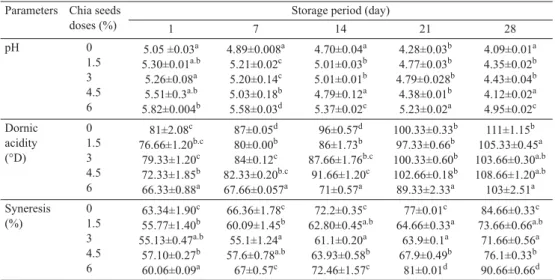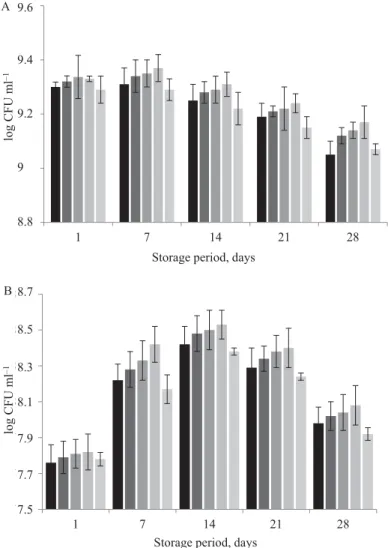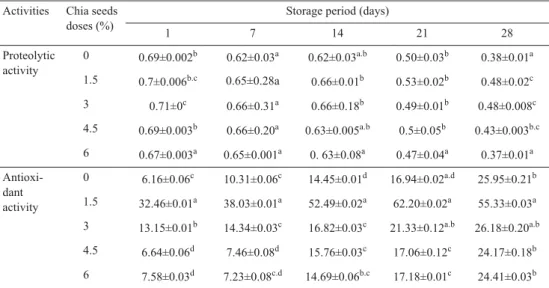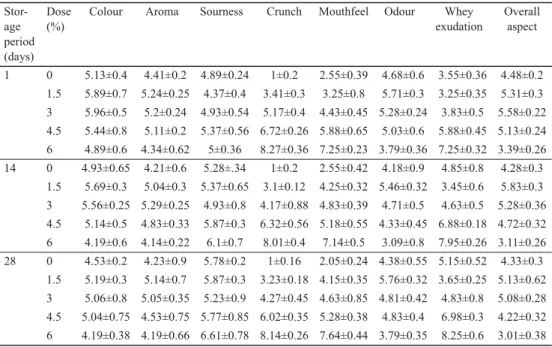DOI: 10.1556/066.2020.49.4.5
EFFECTS OF CHIA SEED LEVELS ON QUALITY AND BIO-FUNCTIONAL PROFILE OF STIRRED YOGHURT
O. B M *, E. R , M. B and M. H
Research Unity ‘Bio-Preservation and Valorization of Agricultural Products UR13-AGR 02’, Higher Institute of Food Industries of Tunisia (ESIAT), Carthage University. Tunisia
(Received: 22 February 2020; accepted: 25 May 2020)
Yoghurt is considered as a healthy food. Thus, it could convey functional and bioactive ingredients. Chia seeds are of great interest due to their ability to improve consumer health. In this study, chia seeds were added to stirred yoghurt at diff erent doses (1.5, 3, 4.5, or 6%). The eff ects of chia seeds on physicochemical, microbiological, and sensory qualities were assessed during 28 days of refrigerated storage. The results showed that chia seeds slightly decreased post-acidifi cation, the lowest value was obtained in yogurt with 3% chia seeds (24°D), but syneresis rose signifi cantly (P<0.05) when 6% of chia seeds was added. Furthermore, chia seeds promote viability of yoghurt bacteria, and antioxidant activity reached 62.20±0.02% in yoghurt added with 1.5% chia seeds. However, proteolysis is not aff ected. The eff ects of chia seeds were not dose dependent as 4.5% and 6% did not follow trend. These fi ndings were affi rmed by sensory characteristics. Thus, stirred yoghurt containing 1.5 or 3% of chia seeds proved to be the most adequate choices.
Keywords: chia, dose, yoghurt, quality, bio-functional
Yoghurt is one of the most popular fermented dairy products owing to its sensory characteristics and nutritional and health benefi ts (D et al., 2019). It promotes gut health and has a hypocholesterolemic action (F et al., 2019; S et al., 2019). Actually, a vast array of yoghurts exists to suit all palates, with multiple features. Bioactive compounds such as probiotics and prebiotics are usually added to yoghurts to enhance functionality, quality, and therapeutic properties (C et al., 2013). On the other hand, fruit fi bre, pulp, or seed extract supplementations were only recently tested (H et al., 2020; K et al., 2020) to promote either yoghurt benefi ts and/or quality.
Seed from Salvia hispanica L. or more commonly known as chia is a traditional food in Central and South America. Currently, it is widely consumed for various health benefi ts, especially in maintaining healthy serum lipid level. This eff ect is enhanced by the presence of phenolic acid and omega 3/6 oil in chia seed (M -T et al., 2019). Chia also promotes glycaemic index and weight loss due to high dietary fi bre content (J et al., 2016). Human dietary chia is usually consumed raw in salads as sprouts or seeds and added to beverages. Recently, it was also used in some foods as ingredient (A P et al., 2020;
P et al., 2020). The use of chia as an ingredient in the processing of widely consumed foods, such as dairy products, appears to be a promising approach. However, to the best of our knowledge, no study has been done on the utilisation of chia seeds in yogurt.
So, the objective of the current work was to evaluate the eff ect of chia seed fortifi cation at diff erent doses (0, 1.5, 3, 4.5, 6%) on the quality (biochemical, bio-functional, microbiological, and sensory parameters) of stirred yoghurt during 28 days of refrigerated storage.
* To whom correspondence should be addressed.
E-mail: olfajameel@yahoo.fr
1. Materials and methods
1.1. Stirred yoghurt production
Non-fat milk was pasteurised at 95 °C for 3 min. Then it was rapidly cooled down to 43±1
°C and divided into fi ve batches. Milks were fermented by direct inoculation with mixed starter culture at 3% (YS 131 with Streptococcus thermophilus and Lactobacillus bulgaricus from DSM dairy cultures, USA). The inoculated milk was incubated at 43 °C until the pH reached 4.6 and acidity reached 75 °D, and then cooled and stored at 4°C. Thereafter, chia seeds were added to each batch at 0, 1.5%, 3%, 4.5% and 6%. The gel was broken by stirring with a glass rod (10 times clockwise; 10 times anticlockwise). Yoghurts were fi lled into 100 ml glass jars and stored at 4 °C for 28 days. Dornic acidity, pH, syneresis, proteolytic activity, antioxidant activity, and lactic acid bacterium counts were determined after 24 h of production and each week for 4 weeks of refrigerated storage. Sensory measurements were evaluated at the beginning and on the 14th and 28th days of storage.
1.2. Yoghurt analysis
1.2.1. Post-acidifi cation. Post-acidifi cation was evaluated by measurement of pH and Dornic acidity of yoghurt (expressed as degree Dornic).
1.2.2. Syneresis. The gel was stirred at 4 °C for 60 s and centrifuged for 20 min at 12 075 g in an ultracentrifuge (Beckman USA). Syneresis (%) was calculated as the mass of the separated serum from the gel after centrifugation, in relation to the total mass of gel that was centrifuged (K et al., 2020).
1.2.3. Yoghurt bacteria enumeration. The counts of Streptococcus salivarius subsp.
thermophilus and Lactobacillus delbruekii subsp. bulgaricus were determined at 37 °C and 24 h using M17 and MRS medium, respectively (D I , 2001). The results were expressed as CFU ml–1.
1.2.4. Proteolytic activity. The proteolytic activity of the yoghurt was determined using the OPA method. The procedure was described by D and co-workers (2005).
1.2.5. Antioxidant activity. Antioxidant activity was evaluated following DPPH assay according to the procedure by H and co-workers (1988).
1.2.6. Sensory evaluation. Throughout the storage period at 4 °C (1st, 14th, and 28th day), the sensory properties of experimental yoghurts were evaluated according to the method described by J and co-workers (2016). Jury of panellists consisted of 20 trained members (8 male and 12 female, aged between 24 and 45 years). The trained panellists were students and professors from the Tunisian Higher Institute of Food Industry. The test was performed inside a uniformly illuminated room, at approximately 25 °C. The obtained yoghurts were coded with a random six-digit number and served to panellists in a randomised order. The main descriptors used to evaluate appearance, taste, and texture were sweet taste, bitter taste, mouth feel, granular texture, whey exudation, white colour, and overall acceptance, on a 9-point scale ( S et al., 2018).
1.3. Statistical analysis
The obtained data were statistically evaluated using one-way analysis of variance (ANOVA) with Ducan’s test for mean comparison to highlight signifi cant diff erences (P<0.05) among yoghurt samples. All experiments were carried out in triplicate.
2. Results and discussion
2.1. Post-acidifi cation and syneresis
Table 1 shows the changes in pH values, Dornic acidity, and syneresis of stirred yoghurt supplemented with diff erent concentrations (0, 1.5, 3, 4.5, and 6%) of chia seeds, stored at 4 °C for 28 days.
Table1. Variations in post-acidifi cation and syneresis of stirred yoghurt containing various doses of chia seeds (0, 1.5, 3, 4.5, and 6%) for 28 days of storage at 4 °C
Parameters Chia seeds doses (%)
Storage period (day)
1 7 14 21 28
pH 0
1.5 3 4.5 6
5.05 ±0.03a 5.30±0.01a.b 5.26±0.08a 5.51±0.3a.b 5.82±0.004b
4.89±0.008a 5.21±0.02c 5.20±0.14c 5.03±0.18b 5.58±0.03d
4.70±0.04a 5.01±0.03b 5.01±0.01b 4.79±0.12a 5.37±0.02c
4.28±0.03b 4.77±0.03b 4.79±0.028b
4.38±0.01b 5.23±0.02a
4.09±0.01a 4.35±0.02b 4.43±0.04b 4.12±0.02a 4.95±0.02c Dornic
acidity (°D)
0 1.5 3 4.5 6
81±2.08c 76.66±1.20b.c
79.33±1.20c 72.33±1.85b 66.33±0.88a
87±0.05d 80±0.00b 84±0.12c 82.33±0.20b.c 67.66±0.057a
96±0.57d 86±1.73b 87.66±1.76b.c
91.66±1.20c 71±0.57a
100.33±0.33b 97.33±0.66b 100.33±0.60b 102.66±0.18b 89.33±2.33a
111±1.15b 105.33±0.45a 103.66±0.30a.b 108.66±1.20a.b 103±2.51a Syneresis
(%)
0 1.5 3 4.5 6
63.34±1.90c 55.77±1.40b 55.13±0.47a.b
57.10±0.27b 60.06±0.09a
66.36±1.78c 60.09±1.45b 55.1±1.24a 57.6±0.78a.b 67±0.57c
72.2±0.35c 62.80±0.45a.b
61.1±0.20a 63.93±0.58b 72.46±1.57c
77±0.01c 64.66±0.33a
63.9±0.1a 67.9±0.49b 81±0.01d
84.66±0.33c 73.66±0.66a.b 71.66±0.56a 76.1±0.33b 90.66±0.66d Values in a column with diff erent letters are signifi cantly diff erent at P<0.05. Data means ± standard deviation (n=3).
Post-acidifi cation of the yoghurts showed an increase over the storage period, pH values of all yoghurts decreased (ΔpH reached 1.39) and Dornic acidity values increased. Indeed, acid-production trend during storage was similar to other research studies (C et al., 2013).
Whereas, a slight increase of pH was observed in yoghurts supplemented with chia seeds compared to the control. It could be due to some chia fi bres diff used in yoghurt gel. Similarly, E S and co-workers (2012) reported that the pH of yoghurts with fruit or fruit fi bre was higher than that of their respective controls without fruit or fruit fi bre. They indicated that lactic acid bacteria in the presence of some fruity products or fi bres may reduce their organic acid production.
Syneresis levels increased in all samples over the storage period (Table 1). In fact, the evolution of pH and Dornic acidity could change global charge of casein, it becomes negative,
hence, capillary water is kept between casein molecules. These fi ndings are in a good agreement with that of S and co-workers (2010), who reported that syneresis of yoghurt increases during storage. Moreover, it is noteworthy that syneresis values of yoghurts with chia seeds were signifi cantly lower than those of the control yoghurt (P<0.05).
As shown in Table 1, signifi cant diff erences existed. The lowest syneresis percentage units (55.77–55.13%) were observed for 1.5 or 3% chia seeds yoghurt. Syneresis of yoghurt can be aff ected by the quantity of proteins and their properties. Indeed, the major polyphenols of chia seed (chlorogenic and caff eic acids) exhibit high reactivity with proteins, which improves the affi nity between milk proteins, resulting in their cohesion. D and co-workers (2017) reported that when yoghurt was enriched with green coff ee seeds, containing 4.1 to 11.3 g of chlorogenic acid/100 g, syneresis was improved by stabilizing the gel structure.
Furthermore, both viscosity and syneresis signifi cantly increased in yoghurt supplemented with green tea, which is rich in polyphenols (J et al., 2018). However, the diff erences in syneresis were not dose dependent. Values obtained with 4.5 or 6% of chia were higher than those obtained with 1.5 or 3%, but they still remained below the syneresis of the control sample. As a result, high concentration of chia seeds raised the concentration of mucilage, which is able to reduce polyphenolic compounds in fermented milk. Indeed, S -C and co-workers (2013) reported that chia mucilage is capable of retaining water, as well as preventing its access inside the seed, so water will not be available to act as a solvent.
2.2. Yoghurt starter’s growth
As shown in Figure 1A and 1B, yoghurt bacteria counts were up to standards (≥109 CFU ml–1 for streptococci and ≥107 CFU ml–1 for lactobacilli) during the storage. However, Lactobacillus bulgaricus colony numbers (expressed in log CFU ml–1) were weaker than S. thermophilus, as reported by other authors (C et al., 2013). In all yoghurt samples, S. thermophilus and L. bulgaricus counts increased slightly for 7 and 14 days, respectively. Then they decreased by the end of the 28 days of refrigerated storage. Indeed, lactic acid exerts an inhibiting eff ect on S. thermophilus, lowering their count. Lactobacillus bulgaricus and S. thermophilus counts were higher in yoghurts enriched by chia seeds. The same behaviour was previously observed in yoghurts enriched with fruit fi bres (E S et al., 2012), which confi rms the prebiotic eff ect of plants, as the viability of yoghurt bacteria can be increased by chlorogenic acid and caff eic acid derived from plant leaf extracts (O et al., 2016).
2.3. Proteolytic and antioxidant activities
Main activities (proteolytic and antioxidant) of yoghurt bacteria were assessed during storage (Table 2). Proteolytic activities were regularly monitored during the fi rst two weeks; they ranged between 0.65±0.03 to 0.71±0.01. They decreased between 14 and 28 days of refrigeration to 0.37±0.01. This profi le was in line with viability of lactic acid bacteria.
Meanwhile, chia seeds did not aff ect proteolytic activities (P>0.05). Lactic acid bacteria were characterised by their high demand for essential growth factors, such as peptides and amino acids. Proteinases and peptidases constitute the primary enzymes in lactic acid bacteria responsible for proteolysis in milk proteins as a source of amino acids and nitrogen (C et al., 2013).
B 8,8
9 9,2 9,4 9,6
1 7 14 21 28
log CFU ml–1
Storage period, days
7,5 7,7 7,9 8,1 8,3 8,5 8,7
1 7 14 21 28
log CFU ml–1
Storage period, days 8.7
8.5 8.3 8.1 7.9 7.7 7.5 9.6
9.4
9.2
9
8.8 A
Fig. 1. Viable counts of streptococci (A) and lactobacilli (B) (expressed as log CFU ml–1) in yoghurt samples (control, enriched with 1.5, 3, 4.5, and 6% of chia seeds) during storage period (fi rst, 7th, 14th, 21st and 28th days)
: Control; : 1.5%; : 3%; : 4.5%; : 6%
Regarding the antioxidant activity of all yoghurt samples, the reducing power rose signifi cantly (P<0.05) during the storage period (Table 2). Yoghurts containing chia seeds had higher reducing power capacity than the control. It reached 62.20±0.02% at the 21st day of storage in yoghurt with 1.5% supplementation. In fact, chia seed contains abundant amounts of polyphenols with antioxidant activity because of the presence of components such as α-linolenic acid, chlorogenic acid, and caff eic acid ( F et al., 2017). These chia seed components showed strong antioxidant and anti-infl ammatory eff ects (M -T et al., 2019) that can provide additional bioactive properties to yoghurt. However, highest
reducing power was obtained for 1.5% of chia, but when 4.5 or 6% of chia seeds were added, the reducing power decreased. As a result, as discussed previously, mucilaginous gel formed when high concentration of chia seeds was used that could inhibit the availability of polyphenols in the environment.
Table 2. Changes in proteolytic and antioxidant activities in yoghurts with added chia seeds at diff erent doses (0, 1.5, 3, 4.5, and 6%) for 28 days of storage at 4 °C
Activities Chia seeds doses (%)
Storage period (days)
1 7 14 21 28
Proteolytic activity
0 0.69±0.002b 0.62±0.03a 0.62±0.03a.b 0.50±0.03b 0.38±0.01a 1.5 0.7±0.006b.c 0.65±0.28a 0.66±0.01b 0.53±0.02b 0.48±0.02c 3 0.71±0c 0.66±0.31a 0.66±0.18b 0.49±0.01b 0.48±0.008c 4.5 0.69±0.003b 0.66±0.20a 0.63±0.005a.b 0.5±0.05b 0.43±0.003b.c 6 0.67±0.003a 0.65±0.001a 0. 63±0.08a 0.47±0.04a 0.37±0.01a Antioxi-
dant activity
0 6.16±0.06c 10.31±0.06c 14.45±0.01d 16.94±0.02a.d 25.95±0.21b 1.5 32.46±0.01a 38.03±0.01a 52.49±0.02a 62.20±0.02a 55.33±0.03a 3 13.15±0.01b 14.34±0.03c 16.82±0.03c 21.33±0.12a.b 26.18±0.20a.b 4.5 6.64±0.06d 7.46±0.08d 15.76±0.03c 17.06±0.12c 24.17±0.18b 6 7.58±0.03d 7.23±0.08c.d 14.69±0.06b.c 17.18±0.01c 24.41±0.03b Values in a column with diff erent letters are signifi cantly diff erent at P<0.05. Data means ± standard deviation (n=3).
2.4. Sensory evaluation
Table 3 represents comparative sensory analysis among yoghurts supplemented with diff erent doses of chia seeds (0, 1.5, 3, 4.5, and 6%) using scoring methodology, after storage for 1, 14, and 28 days. The aroma, colour, odour, and overall aspect rose with chia seed supplementation.
High scores were obtained with 1.5 and 3% at each storage period, but 6% yoghurt did not follow the trend. Also, addition of 1.5 and 3% seeds lowered the sourness and whey exudation scores. These fi ndings agree with previous discussion on the yoghurt quality. On the other hand, the seeds gave the yoghurt crunchiness, appreciated by panellists, and it positively aff ected mouthfeel. The best stirred yoghurt obtained is the one enriched with 1.5 or 3% of seeds. Likewise, P and co-workers (2018) have used projective techniques, namely shopping list and free word association. These authors reported that functional dairy products could also be considered as foods with striking sensory characteristics due to their superior quality. In this context, it highlighted the need to implement preferred attribute elicitation methodology (S et al., 2020) and multidimensional analysis (T et al., 2017) to evaluate consumer perception of new functional product.
Table 3. Variations in sensory evaluation of yoghurt containing various doses of chia seeds (0, 1.5, 3, 4.5, and 6%) for 28 days of storage at 4 °C
Stor- age period (days)
Dose (%)
Colour Aroma Sourness Crunch Mouthfeel Odour Whey
exudation
Overall aspect
1 0 5.13±0.4 4.41±0.2 4.89±0.24 1±0.2 2.55±0.39 4.68±0.6 3.55±0.36 4.48±0.2 1.5 5.89±0.7 5.24±0.25 4.37±0.4 3.41±0.3 3.25±0.8 5.71±0.3 3.25±0.35 5.31±0.3 3 5.96±0.5 5.2±0.24 4.93±0.54 5.17±0.4 4.43±0.45 5.28±0.24 3.83±0.5 5.58±0.22 4.5 5.44±0.8 5.11±0.2 5.37±0.56 6.72±0.26 5.88±0.65 5.03±0.6 5.88±0.45 5.13±0.24 6 4.89±0.6 4.34±0.62 5±0.36 8.27±0.36 7.25±0.23 3.79±0.36 7.25±0.32 3.39±0.26 14 0 4.93±0.65 4.21±0.6 5.28±.34 1±0.2 2.55±0.42 4.18±0.9 4.85±0.8 4.28±0.3
1.5 5.69±0.3 5.04±0.3 5.37±0.65 3.1±0.12 4.25±0.32 5.46±0.32 3.45±0.6 5.83±0.3 3 5.56±0.25 5.29±0.25 4.93±0.8 4.17±0.88 4.83±0.39 4.71±0.5 4.63±0.5 5.28±0.36 4.5 5.14±0.5 4.83±0.33 5.87±0.3 6.32±0.56 5.18±0.55 4.33±0.45 6.88±0.18 4.72±0.32 6 4.19±0.6 4.14±0.22 6.1±0.7 8.01±0.4 7.14±0.5 3.09±0.8 7.95±0.26 3.11±0.26 28 0 4.53±0.2 4.23±0.9 5.78±0.2 1±0.16 2.05±0.24 4.38±0.55 5.15±0.52 4.33±0.3 1.5 5.19±0.3 5.14±0.7 5.87±0.3 3.23±0.18 4.15±0.35 5.76±0.32 3.65±0.25 5.13±0.62 3 5.06±0.8 5.05±0.35 5.23±0.9 4.27±0.45 4.63±0.85 4.81±0.42 4.83±0.8 5.08±0.28 4.5 5.04±0.75 4.53±0.75 5.77±0.85 6.02±0.35 5.28±0.38 4.83±0.4 6.98±0.3 4.22±0.32 6 4.19±0.38 4.19±0.66 6.61±0.78 8.14±0.26 7.64±0.44 3.79±0.35 8.25±0.6 3.01±0.38
3. Conclusions
In conclusion, the addition of 1.5 or 3% of chia seeds to stirred yoghurts reduced post- acidifi cation and syneresis and improved viability and antioxidant activity of lactic acid bacteria during refrigerated storage. The sensory quality scores indicated that yoghurts enriched with 1.5 or 3% of seeds were appreciated. Eff ects of chia seeds are not dose dependent, since they are mucilaginous. Based on the obtained results, the utilisation of chia seeds in dairy industries would lead to a more convenient fermented milk product that satisfi es consumers and provides health benefi ts due to its great nutritional contents.
*
The authors wish to acknowledge Research Unity of the High School of Food Industries (UR13-AGR 02) for supporting this research.
References
A P , M., B , J.C., R , I., S M , P.E. T , M.A. (2020): Improving the lipid profi le of bologna type sausages with Echium (Echium plantagineum L.) oil and chia (Salvia hispanica L.) fl our. LWT – Food Sci. Technol., 119, 108907.
C , A.G., C , R.N., G , L.M.R., S ’A , A.S., N , L.C., … B , H.M.A.
(2013): Developing a prebiotic yogurt, rheological, physico-chemical and microbiological aspects and adequacy of survival analysis methodology. J. Food Eng., 114, 323–330.
D , K., C , R. T -W , K.A. (2019): Eff ects of new technology on the current manufacturing process of yogurt-to increase the overall marketability of yogurt. LWT – Food Sci. Technol., 108, 6980.
S , H.L.A., B , C.F., S , R., V , A.H., C , R.G.B., … C , A.G. (2018): Sodium reduction and fl avor enhancer addition in probiotic prato cheese. Contributions of quantitative descriptive analysis and temporal dominance of sensations for sensory profi ling. J. Dairy Sci., 101, 1–10.
F , B., A , M. L , V. (2017): Chia seeds products: An overview. Phytochem. Rev., 16, 745–760.
D , O.N., H , A., V , T. S , N.P. (2005): Probiotic strains as starter cultures improve angiotensin-converting enzyme inhibitory activity in soy yoghurt. J. Food Sci., 70(8), 375–381.
D , O., M , B.A. G , V. (2017): Syneresis and rheological behaviors of set yogurt containing green tea and green coff ee powders. J. Dairy Sci., 100, 901–907.
D , F.P. I , K. (E ) (2001): Compendium of methods for microbiological examination of food. American Public Health Association (APHA), (4th ed.) Washington, DC.
E S , A.P., C , N.S., S , T.F., S , F.A.S.M., G L , A., … O , M.N.
(2012): Fibers from fruit by-products enhance probiotic viability and fatty acid profi le and increase CLA content in yoghurts. Int. J. Food Microbiol., 154, 135–144.
F , S., U , F., A , S., Z , H., K , A. H -U , R. (2019): Hypolipidaemic eff ects of synbiotic yoghurt in rabbits. Int. J. Dairy Technol., 72(4), 545–550.
H , E., B , G., G , V., A , E., G , V. G , I. (2020): Functional stability of goats’ milk yoghurt supplemented with Pistacia atlantica resin extracts and Saccharomyces boulardii. Int J. Dairy Technol., 73(1), 134–143.
H , T., K , H., Y , T. O , T. (1988): Two new fl avonoids and other constituents in licorice root: their relative astringency and radical scavenging eff ect. Chem. Pharm. Bull., 36, 1090–1097.
J , D.R., P , T.C., C , A.G. P , S.H. (2016): Strawberry-fl avored yogurts and whey beverages: What is the sensory profi le of the ideal product? J. Dairy Sci., 99, 5273–5283.
J , A.L., B , C., J , E., A -Y , F., H , H.V.T., … V , V. (2016): Eff ect of salba- chia (Salvia hispanica L.), an ancient seed, in the treatment of overweight and obese patients with type 2 diabetes: A double-blind, parallel, randomized controlled trial. FASEB J., 30, 126.2.
J , C.H., R , H., Z , T., L , C.H., S , H.G. H , S.G. (2018): Green tea powder supplementation enhances fermentation and antioxidant activity of set-type yogurt. Food Sci. Biotechnol., 27, 1419–142 7.
K , M.A., G , Z., K , E.M. B , R.Z. (2020): Probiotic yoghurt functionalised with microalgae and Zedo gum: Chemical, microbiological, rheological and sensory characteristics. Int. J. Dairy Technol., 73(1), 67–75.
M -T , N., D V , J.A., O E -C , G., C , E.L., M , A. … B ,
M.I. (2019): Enrichment of sheep cheese with chia (Salvia hispanica L.) oil as a source of omega-3. LWT – Food Sci. Technol., 108, 407–415.
O , N.S, L , J.Y., J , J.Y.K., K ., S., S , Y.K., …. K , Y. (2016): Microbiological characterization and functionality of set-type yogurt fermented with potential prebiotic substrates Cudraniatricus pidata and Morus alba L. leaf extracts. J. Dairy Sci., 99, 6014–6025.
P , N.B., A , C., M , A.L., A , A., ... B , V.M. (2020): Chemical profi le and bioaccessibility of polyphenols from wheat pasta supplemented with partially-deoiled chia fl our. LWT – Food Sci. Technol., 124, 109–134.
P , L.P.F., S , H.L.A., K , S.P., M , P.M., O F.L.C., … F , M.Q. (2018):
Understanding perceptions and beliefs about diff erent types of fermented milks through the application of projective techniques: A case study using Haire’s shopping list and free word association. J. Sens. Stud., 33(1), e12326.
S -C , M., C -D , G., C -P , J., F -R , R.R., M -M ,
J.V. D -R , M. (2013): Chia (Salvia hispanica L.) seed mucilage release characterization – A microstructural and image analysis study. Ind. Crop. Prod., 51, 453–462 .
S , A., R , H.R., F , U., A , K., H , Z., … N , H.R. (2019): Antimicrobial and antidiabetic potential of synbiotic fermented milk: A functional dairy product. Int. J. Dairy Technol., 72(1), 15–22.
S , E.K.B., S , R., S , W.P., K , S.P, M , P.M., … E , E.A. (2020): An intra- cultural investigation in Brazil using Coalho cheese and preferred attribute elicitation. J. Sens. Stud., 35(1), e12543.
S , P., W , T. R , P. (2010): Characteristics and shelf-life of corn milk yoghurt. CMU J. Nat. Sci., 9, 133–147
T , F.R., E , E.A., T C , B., F , L.L., G , D., … C , A.G. (2017): Rapid consumer-based sensory characterization of requeijão cremoso, a spreadable processed cheese: Performance of new statistical approaches to evaluate check-all-that-apply data, J. Dairy Sci., 100(8), 6100–6110.



